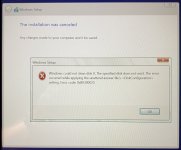csphelps
Member
- Joined
- Nov 13, 2021
- Messages
- 7
- Reaction score
- 0
This computer is very new (August 2021) and have upgraded the memory from 8Gb to 32Gb and the NVME m.2 from the 512Gb to a Phison 4Tb. The NVME is the only drive in the system. The BIOS recognizes everything with no problems and when I do a recovery from the HP recovery media everything works as it should. I have no problems running the recovered Windows and Linux Ubuntu on separate partitions, as long as I use the Windows recovery media. Linux Ubuntu installs from it’s install media perfectly on the computer with no issues, recognizing everything.
When I do a clean install with Windows 10, it used to allow me to direct it to where the drivers were (I couldn’t get the Win10 media to work either) but Windows 11 does not allow me to do that now. I have tried injecting the drivers for the Phison (they use Sabrent drivers) directly into the installation but that doesn’t work either.
When I do the installation, at the beginning it tries formatting the drive without asking where I want the installation to be put or allowing me to change the partitions like it’s getting directions from an answer file. This media is created directly from an ISO download from Microsoft’s website and the hash matches with no issues. I have not included any answer file with the media so I don’t know where it’s getting it’s information to proceed without any secondary input. I have read in other forums that the problem may lie with Intel’s Rapid Storage Technology drivers and it not recognizing the drive because of that, but I’m not real sure. I have tried injecting these into the media as well with no luck.
Microsoft and it’s vendors put so much crap in with the installation that I would really like to do a clean install with a minimal amount of crap that’s included with the clean install, but I’m at a loss with what to do. I’m about at the point where I’m going to drop Microsoft altogether if I can’t do this.
I’m uploading the specs from HWiNFO.
When I do a clean install with Windows 10, it used to allow me to direct it to where the drivers were (I couldn’t get the Win10 media to work either) but Windows 11 does not allow me to do that now. I have tried injecting the drivers for the Phison (they use Sabrent drivers) directly into the installation but that doesn’t work either.
When I do the installation, at the beginning it tries formatting the drive without asking where I want the installation to be put or allowing me to change the partitions like it’s getting directions from an answer file. This media is created directly from an ISO download from Microsoft’s website and the hash matches with no issues. I have not included any answer file with the media so I don’t know where it’s getting it’s information to proceed without any secondary input. I have read in other forums that the problem may lie with Intel’s Rapid Storage Technology drivers and it not recognizing the drive because of that, but I’m not real sure. I have tried injecting these into the media as well with no luck.
Microsoft and it’s vendors put so much crap in with the installation that I would really like to do a clean install with a minimal amount of crap that’s included with the clean install, but I’m at a loss with what to do. I’m about at the point where I’m going to drop Microsoft altogether if I can’t do this.
I’m uploading the specs from HWiNFO.
Attachments
Last edited:

